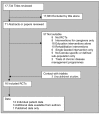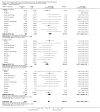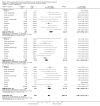Stroke liaison workers for stroke patients and carers: an individual patient data meta-analysis
- PMID: 20464736
- PMCID: PMC6464840
- DOI: 10.1002/14651858.CD005066.pub2
Stroke liaison workers for stroke patients and carers: an individual patient data meta-analysis
Abstract
Background: Many patients experience depression, social isolation and anxiety post stroke. These are associated with a poorer outcome. Ameliorating these problems may improve patient wellbeing.
Objectives: To evaluate the impact of a healthcare worker or volunteer whose multi-dimensional roles have been grouped under the title 'stroke liaison worker'.
Search strategy: We searched the Cochrane Stroke Group Trials Register (searched February 2009), the Cochrane Central Register of Controlled Trials (CENTRAL) (The Cochrane Library Issue 1, 2009), MEDLINE (1966 to 2009), EMBASE (1980 to 2009) and four other databases. We performed a cited reference search, searched conference proceedings and trials registers, checked reference lists and contacted authors and trial investigators.
Selection criteria: Randomised controlled trials investigating the impact of a stroke liaison worker versus usual care.
Data collection and analysis: We invited trialists to participate in a review of individual patient data. Primary outcomes for patients were subjective health status and extended activities of daily living. Primary outcomes for carers were subjective health status including measures of carer strain.
Main results: We included 16 trials involving 4759 participants. Analysis did not show a significant overall difference for subjective health status (standardised mean difference (SMD) -0.03, 95% confidence interval (CI) -0.11 to 0.04, P = 0.34) or extended activities of daily living (SMD 0.04, 95% CI -0.03 to 0.11, P = 0.22). There was no overall significant effect for the outcome of carer subjective health status (SMD 0.04, 95% CI -0.05 to 0.14, P = 0.37). Patients with mild to moderate disability (Barthel 15 to 19) had a significant reduction in dependence (odds ratio (OR) 0.62, 95% CI 0.44 to 0.87, P = 0.006). This would equate to 10 fewer dependent patients (95% CI 17 fewer to 4 fewer) for every 100 patients seen by the stroke liaison worker. Similar results were seen for the outcome of death or dependence for the subgroup with Barthel 15 to 19 (OR 0.55, 95% CI 0.38 to 0.81, P = 0.002). This risk difference equates to 11 fewer dead or dependent patients (95% CI 17 fewer to 4 fewer) for every 100 patients seen by the stroke liaison worker.
Authors' conclusions: There is no evidence for the effectiveness of this multifaceted intervention in improving outcomes for all groups of patients or carers. Patients with mild to moderate disability benefit from a reduction in death and disability. Patients and carers do report improved satisfaction with some aspects of service provision.
Conflict of interest statement
Graham Ellis: has been involved in trials evaluated in this review.
Jonathan Mant: received research funding from The Stroke Association, UK and was an investigator in one of the trials included in this review.
Peter Langhorne: none known.
Martin Dennis: was the chief investigator of one of the included randomised controlled trials. He is also a member of the Council, Executive and Research Committee of Chest Heart and Stroke Scotland, a charity which employs stroke liaison workers.
Simon Winner: has been involved in the design, conduct and publication of an eligible study for this review, resulting in the following publications:
Mant J, Carter J, Wade D, Winner S. Family support for stroke: a randomised controlled trial.
Lancet 2000;356:808‐13.Mant J, Winner S, Roche J, Wade DT. Family support for stroke: one year follow up of a randomised controlled trial.
Journal of Neurology, Neurosurgery & Psychiatry 2005;76:1006‐8.
He has no other competing interests to declare.
Figures





















































Update of
- doi: 10.1002/14651858.CD005066
References
References to studies included in this review
-
- Clark MS, Rubenach S, Winsor A. A randomized controlled trial of an education and counselling intervention for families after stroke. Clinical Rehabilitation 2003;17:703‐12. - PubMed
-
- Glass TA, Berkman LF. Psychosocial intervention in stroke: a progress report from the FIRST study. Gerontologist 1998;38:138.
- Glass TA, Berkman LF, Hiltunen EF, Furie K, Glymour MM, Fay ME, et al. The families in recovery from stroke trial (FIRST): primary study results. Psychosomatic Medicine 2004;66:889‐97. - PubMed
-
- Dennis M, O'Rourke S, Slattery J, Staniforth T, Warlow C. Evaluation of a stroke family care worker: results of a randomised controlled trial. BMJ 1997;314:1071‐7. - PMC - PubMed
- O'Rourke S, MacHale S, Signorini D, Dennis M. Detecting psychiatric morbidity after stroke: comparison of the GHQ and HAD scale. Stroke 1998;29:980‐5. - PubMed
-
- Ellis G, Rodger J, McAlpine C, Langhorne P. The impact of stroke nurse specialist input on risk factor modification: a randomised controlled trial. Age and Ageing 2005;34(4):389‐92. - PubMed
- McManus JA, Craig A, McAlpine C, Langhorne P, Ellis G. Does behaviour modification affect post‐stroke risk factor control? Three year follow‐up of a randomized controlled trial. Clinical Rehabilitation 2009;23:99‐105. - PubMed
References to studies excluded from this review
-
- Allen KR, Hazelett S, Jarjoura D, Wickstrom GC, Hua K, Weinhardt J, et al. Effectiveness of a postdischarge care management model for stroke and transient ischaemic attack: a randomised controlled trial. Journal of Stroke and Cerebrovascular Diseases 2002;11:88‐98. - PubMed
-
- Banet GA, Felclia MA. The potential utility of a shared medical record in a 'first time' stroke population. Journal of Vascular Nursing 1997;15:29‐33. - PubMed
-
- Blake K. Evaluation of stroke family support services. National Research Register2001.
-
- Boquan Z, Xiqing B, Zhaofu C. Effect of supported psychological intervention on anxiety after stroke: a controlled prospective study. Chinese Mental Health Journal 2001;15(6):415‐8.
-
- Carter J, Wade D, Mant J, Winner S. The impact of an information pack on patients with stroke and their carers: a randomised controlled trial. Clinical Rehabilitation 1998;12(2):161‐2. - PubMed
References to ongoing studies
-
- Graven C. From rehabilitation to recovery: a model to optimise consumer and carer involvement in the first year post stroke. Australian New Zealand Clinical Trials Registry (ANZCTR) http://www.anzc...2008.
-
- LoTS‐Care Stroke System of Care Trial Team. Cluster randomised trial evaluation of a patient and carer‐centred system of longer‐term stroke care. Proceedings of the 17th European Stroke Conference. Nice, France, 13‐16 May 2008:Abs 80.
-
- Mayer C, Chan R, Hachinski V. Partners: Promoting Adherence to Regimen of risk factor modification by Trained volunteers or Nurses Evaluated against Regular practice Study. International Journal of Stroke 2008;3 Suppl 1:321.
-
- Sveen U. Thriving, activity and social participation after stroke. ClinicalTrials.gov2007.
Additional references
-
- Bamford J, Sandercock P, Dennis M, Burn J, Warlow C. A prospective study of acute cerebrovascular disease in the community: the Oxfordshire Community Stroke Project 1981‐86 2. Incidence, case fatality rates and overall outcome at one year of cerebral infarction, primary intracerebral and subarachnoid haemorrhage. Journal of Neurology, Neurosurgery and Psychiatry 1990;53:16‐22. - PMC - PubMed
-
- Barker WH, Mullooly JP. Stroke in a defined elderly population, 1967‐85. Stroke 1997;28:284‐90. - PubMed
-
- Bonita R, Broad JB, Beaglehole R. Changes in stroke incidence and case‐fatality in Auckland, New Zealand, 1981‐91. Lancet 1993;342:1470‐3. - PubMed
Publication types
MeSH terms
LinkOut - more resources
Full Text Sources
Medical

